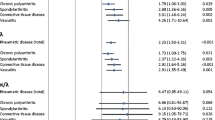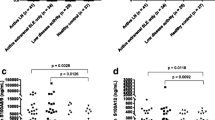Abstract
This paper reports preliminary evidence suggesting that measurements of free light-chain Ig (FLIg) in urine may represent quantitative markers ofin vivo polyclonal B-cell activation. Thus, longitudinal levels of urinary FLIg in patients with systemic lupus erythematosus (SLE) may be used to track or monitor thein vivo immunopathologic B-cell activity of SLE and be helpful in predicting a disease relapse. Our findings showed that dramatic rises in urinary FLIg occurred during asymptomatic intervals that preceded by 4–8 weeks the first symptomatic signs of acute SLE relapse. These results suggest that a sizable lead time may exist between the occurrence of immunopathologic B-cell stimulation and the resultant symptoms and tissue damage of immune complex-induced acute inflammation. In these studies the measurement of urinary FLIg was accomplished by an indirect method using ng-sensitive radioimmunoassays (RIAs) that measured isotypic IgG, IgA, IgM, total κ-Ig, and total λ-Ig. As a control for the assessment of renal tubular function and the excretion of low molecular weight proteins in SLE patients, longitudinal measurements of beta-2-microglobulin (B2M) and lysozyme were made using a novel solid-phase3H-biotin RIA technique.
Similar content being viewed by others
References
Lloyd W, Schur PH: Immune complexes, complement, and anti-DNA in exacerbations of systemic lupus erythematosus (SLE). Medicine (Baltimore) 60:208–217, 1981
Levinsky RL, Cameron JS, Soothill JF: Serum immune complexes and disease activity in lupus nephritis. Lancet 1:564–567, 1977
Minter MF, Stollar, BD, Agnello V: Reassessment of the clinical significance of native DNA antibodies in systemic lupus erythematosus. Arth Rheum 22:959–968, 1979
Valentijn RM, van Overhagen H, Hazevoet HM, Hermans J, Cats A, Daha MR, van Es LA: the value of complement and immune complex determinations in monitoring disease activity in patients with systemic lupus erythematosus. Arth Rheum 28:904–913, 1985
Frank MM, Hamburger MI, Lawley TJ, Kimberly RP, Plotz PH: Defective reticuloendothelial system Fc-receptor function in systemic lupus erythematosus. N Engl J Med 300:518–523, 1979
Emelen W, Mannek M: Clearance of circulating DNA-anti-DNA immune complexes in mice. J Exp Med 155:1210–1215, 1982
Taylor RP, Kujala G, Edberg JC, Foreman P, Davis JS, Wright E: The kinetics of clearance of human antibody/dsDNA immune complexes from rabbit circulation: Effects of dsDNA size, rheumatoid factor, and reduction and alkylation of the antibodies. J Immunol 136:3785–3792, 1986
Hopper JE, Papagiannes E: Evidence by radioimmunoassay that mitogen-activated human blood mononuclear cells secrete significant amounts of light chain Ig unassociated with heavy chain. Cell Immunol 101:122–131, 1986
Waldmann TA, Strober W, Mogielnicki RP: The renal handling of low molecular weight proteins. II. Disorders of serum protein catabolism in patients with tubular proteinuria, the nephrotic syndrome, or uremia. J Clin Invest 51:2162–2174, 1972
Nisonoff A, Hopper JE, Spring SB: The Antibody Molecule. New York, Academic Press, 1975, pp 254–255
Andres GA, McClusky RT: Tubular and interstitial renal disease due to immunologic mechanisms. Kidney Int 7:271–289, 1975
Brentjens JR, Sepulveda M, Baliah T, Bentzel C, Erlanger BF, Elwood C, Montes M, Hsu KC, Andres GA: Interstitial immune complex nephritis in patients with systemic lupus erythematosus. Kidney Int 7:342–350, 1975
Schwartz MM, Fenell JS, Lewis ET: Pathologic changes in the renal tubule in systemic lupus erythematosus. Hum Pathol 6:534–547, 1982
Hopper, JE, O'Brien, J, Papagiannes, E: Restriction of blood and marrow CLL-B cells to free L-chain Ig secretion: Implication for normal B-cell function and control. Am J Hematol 29:125–133, 1988
Hopper JE: Comparative studies on monotypic IgM-λ and IgG-κ from an individual patient. I. Evidence for shared VH idiotypic determinants. J Immunol 115:1101–1107, 1975
Hopper JE, Brahn E: Structural evidence for an unblocked VHI subgroup of human heavy chains. J Immunol 119:847–849, 1977
Hopper JE, Haren JM, Kmiecik TE: Evidence for shared idiotypy expressed by the IgM, IgA serum proteins of a patient with a complex multiple paraprotein disorder. J Immunol 122:2000–2006, 1979
Porath J, Axen R, Ernback S: Chemical coupling of proteins to agarose. Nature 215:1491–1493, 1967
Hopper JE, Perna L: A solid phase radioimmunoassay technique that utilizes3H-biotin (submitted)
Evrin PE, Peterson PA, Wide L, Berggard I: Radioimmunoassay of B2-microglobulin with human biologic fluids. Scand J Clin Lab Invest 28:439–443, 1971
Portman RJ, Kissane JM, Robson AM: Use of B2 microglobulin to diagnose tubo-interstitial renal lesions in children. Kidney Int 30:91–98, 1986
Thomas MJ, Russo A, Craswell P, Ward M, Steinhardt I: Radioimmunoassay for serum and urinary lysozyme. Clin Chem 27:1223–1226, 1981
Brower J, van Leeuwen-Herberts T, Otting-van de Riut M: Determination of lysozyme in serum, urine, cerebrospinal fluid, and feces by enzyme immunoassay. Clin Chim Acta 142:21–30, 1984
Yamasaki K, Niho Y, Yanase T: Granulopoiesis in systemic lupus erythematosus. Arth Rheum 26:516–521, 1983
Nagasawa T, Sakurai T, Kashiwagi H, Abe T: Cell-mediated amegakaryocytic thrombocytopenia associated with systemic lupus erythematosus. Blood 67:479–483, 1986
Zoumbos NC, Gascon P, Djeu JY, Trost SR, Young NS: Circulating activated suppressor T lymphocytes in aplastic anemia. N Engl J Med 312:257–265, 1985
Epstein WV: Immunologic events preceding a clinical exacerbation of systemic lupus erythematosus. Am J Med 54:631–636, 1973
Spriggs B, Epstein WV: Clinical and laboratory correlates of L chain proteinuria in systemic lupus erythematosus. J Rheum 1:287–292, 1974
Epstein WV, Grausz H: Favorable outcome in diffuse proliferative glomerulonephritis of systemic lupus erythematosus. Arth Rheum 17:129–142, 1974
Tan M, Epstein WV: A direct immunologic assay of human sera for Bence Jones proteins (L-chains). J Clin Lab Med 66:344–356, 1965
Jerne NK, Roland J, Cozenave PA: Recurrent idiotypes and internal images. EMBO J 1:243–247, 1982
Jorgensen T, Hannestad K: T Helper lymphocytes recognize the VL domain of the isologous mouse myeloma protein 315. Scand J Immunol 10:317–323, 1979
Jorgensen T, Hannestad K: T-Helper cells recognize an iditope located on peptide 88-114/117 of the light chain variable domain of an isologous myeloma protein (315). J Exp Med 158:2183–2188, 1983
Sakato N, Semma M, Eisen NH, Azuma T: A small hypervariable segment in the variable domain of an immunoglobulin light chain stimulates formation of anti idiotypic suppressor T cells. Proc Natl Acad Sci USA 79:5396–5400, 1982
McNamara M, Kohler H: Regulatory idiotypes. Induction of idiotype recognizing helper T cells by free light and heavy chains. J Exp Med 159:623–628, 1984
Jasin HE, Ziff M: Immunoglobulin synthesis by peripheral blood cells in systemic lupus erythematosus. Arth Rheum 18:219–228, 1975
Ginsburg WW, Finkelman FD, Lipsky PE: Circulating and pokeweed mitogen-induced immunoglobulin secretory cells in systemic lupus erythematosus. Clin Exp Immunol 35:76–88, 1979
Blaese RM, Grayson J, Steinberg AD: Elevated immunoglobulin secretory cells in the blood of patients with active systemic lupus erythematosus: Correlation of laboratory and clinical assessment of disease activity. Am J Med 69:345–350, 1980
Sakane T, Suzuki N, Takada S, Ueda Y, Murakawa Y, Tsuchida T, Yamauchi Y, Kishimoto T: B cell hyperactivity and its relation to distinct clinical features and the degree of disease activity in patients with systemic lupus erythematosus. Arth Rheum 31:80–87, 1988
Dixon FJ: Murine lupus: A model for human autoimmunity. Arth Rheum 28:1081–1088, 1985
Author information
Authors and Affiliations
Rights and permissions
About this article
Cite this article
Hopper, J.E., Sequeira, W., Martellotto, J. et al. Clinical relapse in systemic lupus erythematosus: Correlation with antecedent elevation of urinary free light-chain immunoglobulin. J Clin Immunol 9, 338–350 (1989). https://doi.org/10.1007/BF00918666
Accepted:
Issue Date:
DOI: https://doi.org/10.1007/BF00918666




